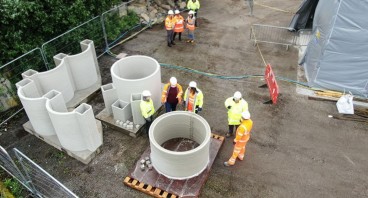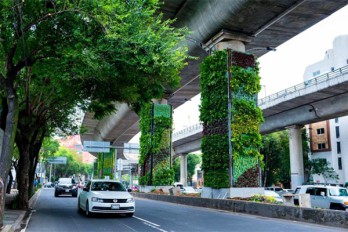U.S. Army Corps of Engineers constructs 3D printed barracks

U.S. Corps of Engineers has achieved a 3-D printed full-scale project that includes concrete walls to rapidly construct barracks for field housing.
The whole attempt aims to efficiently construct safe barracks with precast roofs and 3-D printed walls in a small amount of time. Until now, up to 32x16x9.5 (Length x Width x Height) foot barracks made from about 25 cubic yards of concrete, were realized. The project, named Automated Construction of Expeditionary Structures (ACES), will also investigate printing concrete roof beams in the future. “This exercise had never been done before,” said project officer Captain Matthew Friedell. “People have printed buildings and large structures, but they haven’t done it on site and all at once. This is the first-in-the-world, on-site continuous concrete print.”
Engineering experts from the Chicago office of Skidmore, Owings & Merril studied and conducted tests in order to optimize the project. They showed that 3-D printing can be about 5 times quicker than the current wood-framed barracks approach. ACES utilizes less money and manpower than any other construction method. Researchers also state that it would take just three trained crew members per shift for three continuous printing sessions to build the barracks. Moreover, by using concrete from local sources, the need to ship construction materials for conventional barracks would be eliminated. Captain Matthew Friedell states: “This capability would enable a great partnership with the local community because it is low cost, easy to use, and robotics could print the buildings. We can bring forward better structures, houses and forward operating bases with less manpower and fewer Marines in harm’s way.”
Even if 3-D printed construction is the new trend, it should be pointed out that it is not flawless yet. Skidmore, Owings & Merril state that the printing process must not be interrupted in order to avoid structural imperfections and that it is absolutely necessary to pre-test concrete's performance. Furthermore, ACES utilizes a chevron design that undulates, changing direction every two feet so that cracks from shrinkage will not occur. Tests to improve the procedure will continue the next months. In 2019, ACES hopes to realize 4-5 such projects in the field.
Sources: Theconstructionindex.co.uk, Archpaper.com
Sources: Theconstructionindex.co.uk, Archpaper.com
Want to read more like this story?

3D-printed buildings using soil material
Sep, 24, 2020 | NewsResearchers have developed a new technique to construct a building using a 3-D printer and soil mate...

Revolutionizing Military Engineering with 3D-Printed Concrete Structures
Dec, 09, 2024 | NewsWhen military missions require immediate infrastructure such as bridges or buildings, shipping mate...
The first 3-D-printed, two-story home is under construction in U.S.
Jan, 18, 2023 | NewsA 3D printer is taking home building to a new level. The enormous printer weighing more than 12 ton...

Revolutionizing the Water Industry: The Impact of 3D Concrete Printing
Jun, 13, 2024 | NewsIn an ambitious leap forward, United Utilities, a major water company in North-West England, has pa...

New solution promises 90% cost reduction in concrete 3D printing materials
Dec, 22, 2021 | NewsConcrete 3D printing of building shells has grown considerably in the last few years, with more and...
World’s largest 3D printed building in Florida completed
Jun, 20, 2023 | NewsPrinted Farms, renowned for constructing Florida's initial authorized 3D printed house in Tallahass...

First model house completed in world’s largest 3D printed neighborhood in Texas
Jul, 22, 2023 | NewsLast Saturday, prospective buyers had the chance to tour around the first completed house in the wo...

Towering Achievement: ETH Zurich Completes World’s Tallest 3D-Printed Concrete Structure
May, 23, 2025 | NewsETH Zurich has completed a groundbreaking project in Mulegns, Switzerland: the world’s tallest 3D-p...
World’s largest and longest 3D-printed concrete bicycle bridge: some observations 4 years after its construction
Aug, 21, 2023 | NewsThe BAM construction group constructed the largest and most extensive concrete bridge using 3D prin...
Trending

Vertical gardens in Mexico City to combat pollution

Characteristics of Load Bearing Masonry Construction

Taipei 101’s impressive tuned mass damper

Dutch greenhouses have revolutionized modern farming

The Line at Neom faces feasibility reassessment while construction continues

The Line at Neom faces feasibility reassessment while construction continues

King Salman Gate unveiled adjacent to Mecca’s Grand Mosque

